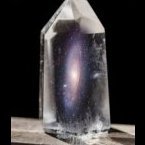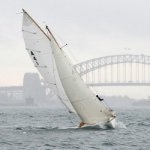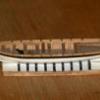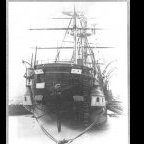Supplies of the Ship Modeler's Handbook are running out. Get your copy NOW before they are gone! Click on photo to order.
×
-
Posts
7,982 -
Joined
-
Last visited
Reputation Activity
-
 Louie da fly got a reaction from J11 in The San Marco mosaic ship c. 1150 by Louie da fly - FINISHED - 1:75
Louie da fly got a reaction from J11 in The San Marco mosaic ship c. 1150 by Louie da fly - FINISHED - 1:75
After a lot of thought I've decided I like the shape of mosaic 'B' the best. But that aftercastle just isn't quite right. I decided to get rid of the strange downward extension aft - as far as I can see that would make it very unseaworthy. But after removing it, it became obvious that the aftercastle itself extends too far aft past the end of the hull; it would unbalance the ship and make her wallow in the waves.
So, what to do? Well, with the Winchelsea nef, there were any number of variations shown in the town seals, which could each be correct for the individual ship shown, but if I wanted to do the Winchelsea ship I should duplicate it as shown on the seal to the best of my ability. But in the case of the San Marco ship, there were five mosaics, all somewhat different, but all supposedly of the exact same ship.
I felt that in this case I was justified in merging the representations, or at least mixing and matching. To me it seemed that the stern overhang of the aftercastles of Mosaics A, C and E (see post # 20 above) was more believable. However, the one on mosaic E comes down below the gunwale, which is very rarely shown in other fairly contemporary ship pictures. I didn't want to do multiple arches (of which more later), so that took out A and C. What I settled on was keeping B's aftercastle but reducing the overhang, possibly sliding it little forward (to incorporate the handles of the side rudders) and shortening it overall.
Here's my side view (you can see how much overhang the aftercastle has - I will be reducing this)
Though there are many representations of aftercastles with solid walls I believe in this case they are made lattice-fashion rather than solid, as shown in the pictures below. With an open poop deck like this, I don't think they were too concerned about protection from the weather.
Or it might even have solid side walls but be open at the back, as this one seems to be.
Earlier in life I was a mediaeval re-enactor and as part of my activity I investigated the Weird and Wacky Weapons of the PBI* and in fact wrote an article about them (http://www.oocities.org/egfrothos/ and follow the "Arms and Armour" link). Most art in the middle ages was religious, and a fruitful source for the weapons of the common soldier is the many portrayals of the Betrayal of Christ, such as the one below in a 12th century manuscript in the Uffizi gallery in Florence - pretty much contemporary with the mosaics of the ship. Regarding the strange phenomenon of pointy things sticking out the back of the aftercastle, I believe these are pole-arms laid to rest.
It's possible that the polearms are resting on the deck, but I think they would get in the way and it's more likely they are in a vertical rack against the side of the aftercastle (or probably both sides).
I've used the Libro di Navigar and Mezza Lune techniques as outlined in Woodrat's Round Ship build log
and come up with this - here's the cross-section at the master frame
I'm not sure if I'll be including through-beams. They're not shown in the mosaic, but that might just be an oversight by the mosaicist.
And front and rear views (side rudders not included on the rear view at the moment, and I might be narrowing the aftercastle somewhat. As the ship gets narrower towards the stern I don't think it needs to be this wide to allow enough room for the side-rudders).
I think the artist has shown the stempost a bit exaggerated - here's how it looks with the sternpost and keel - it does look too big to me.
Compared to the curved stemposts in these 12th century ships from the Leaning tower of Pisa and in the fifth picture from the top in this post.
That's the current state of play. All comments and suggestions welcome.
Steven
* PBI - Poor Bloody Infantry - an Australian term from World War II
-
 Louie da fly got a reaction from J11 in The San Marco mosaic ship c. 1150 by Louie da fly - FINISHED - 1:75
Louie da fly got a reaction from J11 in The San Marco mosaic ship c. 1150 by Louie da fly - FINISHED - 1:75
As I mentioned before, there are five representations of the same ship on the walls of San Marco, in a sort of cartoon strip telling the story of Saint Mark's body being rescued from destruction and smuggled away to its current home in Venice.
The five depictions of the ship are very similar, but each one is slightly different from the others. To get a better handle on just what these differences are, and to get a "feel" for the ship itself, I took a leaf out of Björn Landström's book, by drawing them myself. But as we are now blessed with digital technology he had no access to in the 1960s, I was able to import the five mosaics into AutoCad and trace each one. Here they are:
Note that there are gaps in the tracings. These are where there are human figures obscuring the lines of the ship.
All the ships have three masts, evidently lateen rigged, with what appear to be lanterns (or tops?) at the masthead. In the two pictures where the sails are spread they are decorated - onewith a red cross, the other with two quatrefoils (four-leafed flowers).
All are without a forecastle but wherever it's visible, the stempost curls backward.
All have a "sterncastle", but each one is different. All have some sort of "fretwork", but in some it's square, in others arched. In B and D (and perhaps in A) there is a strange downward extension at the aft end. I have no idea what it is.
All are shown with (usually two) side-rudders in the usual Mediterranean tradition, but the rudders are different shapes. E shows some sort of tackle for controlling the rudders, and has the larboard rudder swivelled upwards. B and D show only a single rudder, but I believe it was simply omitted from the mosaic, not that it represents the ship having a single rudder.
A, B and D show the rudder shaft going into the hull through a circular hole. This is mentioned in what is pretty much the definitive study of rudder evolution The Development of the Rudder A.D. 100-1600 - A Technological Tale by Lawrence V. Mott, but after discussion with Woodrat I've come to agree with him that this is not in fact a practical way of hanging a rudder and must be a result of artist's error. Probably the thing that finally convinced me was looking at the Cocharelli Codex again and discovering that though ships are shown with this feature in a side view, in a stern view it is evident that they are supported outside the hull, from the "sterncastle".
B, D and E have what might be described as cleats sticking up above the gunwales, and in the mosaics they have loops of rope belayed to them (see the second photo in my first post above, though the loops are a bit hard to see). Whereas A has a sort of "battlemented" side.
Two mosaics (C and E) show "wings" at the stern, a common feature of Mediterranean ships of this period.
I've used the Mezza Lune technique to work out the shape of the hull (thanks, Woodrat!). These calculations relate only to the floors - that is once the stempost and sternpost curve up from the keel it no longer applies, and you have to work out how to curve the hull inwards from there to the bow and stern. You can see on the plan view the lines that show the extent of the floors.
and the last pic shows how the frames line up with the hull in B.
Now I have to reconcile these five pictures and choose which features I'm going to go with - or perhaps choose a single mosaic and just go with that one.
Steven
-
 Louie da fly got a reaction from J11 in The San Marco mosaic ship c. 1150 by Louie da fly - FINISHED - 1:75
Louie da fly got a reaction from J11 in The San Marco mosaic ship c. 1150 by Louie da fly - FINISHED - 1:75
Ok, first decision. The bow. Though Woodrat's similar ship has a bow like this:
. . . which explains so many contemporary pictures where it looks mysteriously like this:
. . . on my own it is pretty obvious the bow is different. For example, see the above post and this detail:
The stempost in all examples curves back dramatically (there are slight variations in its configuration but whenever the stempost is visible the reverse curve is always there) and the bow seems to be fairly sharp. This bow shape is reinforced by the so-called Cocharelli Codex (Genoese, 1330-1340) which unusually shows several ships as seen from the front.
This plus the fact that they look remarkably similar to the San Marco ships despite them being almost 200 years apart, leads me to think that this shape co-existed with that shown on Woodrat's ship, and that this is how the bow should be configured.
Steven
-
 Louie da fly got a reaction from sheepsail in The San Marco mosaic ship c. 1150 by Louie da fly - FINISHED - 1:75
Louie da fly got a reaction from sheepsail in The San Marco mosaic ship c. 1150 by Louie da fly - FINISHED - 1:75
In the church of San Marco (Saint Mark's) in Venice is a series of mosaics celebrating the so-called "translation" of the body of Saint Mark from Alexandria to Venice, where he became the city's Patron Saint.
"According to legend, Saint Mark’s body was taken from Alexandria, Egypt, in 828. Two Venetian merchants travelling in Alexandria, obtained the relics of Saint Mark from Priests at the church of Saint Mark, where the saint’s body was interred. The Priests feared Saint Mark’s relics might be damaged or destroyed by the Saracens during the persecution of the Catholic community in Alexandria. Promising to safeguard the Saint’s relics, the merchants convinced the Priests to allow them to return to Venice with the body of Saint Mark.
The body of Saint Mark was taken out of the sarcophagus and unwrapped from its silk shroud, the relic being substituted by another and less eminent Saint. It was then placed in a chest and taken on board the Venetian ship, the merchants first ensuring, that the Saint’s remains were covered by a layer of pork and cabbage. When the Muslim officials asked to inspect the chest, they cried out ‘Kanzir, kanzir’ (Oh horror) at the sight and smell of the pork. . . . Thus the Evangelist was safely conveyed to Venice but not before a number of miracles eased his passage across the Mediterranean.”
There are five mosaic panels showing the ship itself at various stages of the voyage. They are all very much the same - three masted, lateen rigged, with two side-rudders - but with minor variations in the shape of the aftercastle, the stempost, the line of the gunwale etc. Some of these variations don't make a lot of sense and I am going to have to reconcile them and come up with a version that I'm happy with.
This is a rather difficult ship to get a good concept of, but I was inspired by a couple of sketches on a Facebook forum by Wagdemar Lookomsky (I hope he doesn't mind me posting them here) which finally suggested a configuration for this ship that made sense.
I'll be using these as a basis for my own reconstruction, but I won't be copying them exactly.
I will be basing the hull shape mainly on that of the 14th century Contarina ship which Woodrat has already used for his 14th century Venetian Round Ship (see https://modelshipworld.com/topic/17991-venetian-round-ship-13th-century-by-woodrat-132-scale-fully-framed-completed/ ) and I will be shamelessly copying much of his technique in building my own (though at a smaller scale).
However, this is at the research stage at the moment. First I want to get a lot more done on my Great Harry restoration, which as languished while I built my nef.
But this is a bit of a heads-up for those who are interested.
Steven
-
 Louie da fly reacted to Baker in Mary Rose by Baker - scale 1/50 - "Your Noblest Shippe"
Louie da fly reacted to Baker in Mary Rose by Baker - scale 1/50 - "Your Noblest Shippe"
Continuing with the cannons and preparations for the main deck.
The forged iron cannons are constructed from polystyrene tubes, the inner and outer diameters of which differ by 1 mm.
These are then glued to the wooden part (carriage) and provided with an iron pin. They will be finished later.
Making 4 stairs and the support of the deck.
With dry fitted fore castle and (to long) bowsprit
-
 Louie da fly reacted to Slowhand in Apostol Felipe by Slowhand - OcCre - 1:60 - Spanish Galleon
Louie da fly reacted to Slowhand in Apostol Felipe by Slowhand - OcCre - 1:60 - Spanish Galleon
More planking and the wales are going on nicely, bending well.
Need a new pest controller on the slipway
-
 Louie da fly reacted to Alvb in Carrack by Alvb - scale 1:250 - CARD - after Pieter Bruegel's "Landscape with the Fall of Icarus"
Louie da fly reacted to Alvb in Carrack by Alvb - scale 1:250 - CARD - after Pieter Bruegel's "Landscape with the Fall of Icarus"
All cannons and swivel guns are now mounted in the aft fort, so the aft deck can be relocated.
Next, we move on to the forefort.
-
 Louie da fly reacted to Baker in Mary Rose by Baker - scale 1/50 - "Your Noblest Shippe"
Louie da fly reacted to Baker in Mary Rose by Baker - scale 1/50 - "Your Noblest Shippe"
Masts and yards.
During the last vacation, the possible dimensions were drawn up. (All this is largely guesswork).
A few months ago, wood was sawn. pine wood with thin grain. Age?? But the tree was sawn at least 25 years ago.
Nice weather to work outside, So the "lathe" was set up. Own construction, not a pretty thing. But it works.
All masts parts are"semi" ready. Together with the main yard.
-
 Louie da fly reacted to Baker in Mary Rose by Baker - scale 1/50 - "Your Noblest Shippe"
Louie da fly reacted to Baker in Mary Rose by Baker - scale 1/50 - "Your Noblest Shippe"
Smal update.
Started with the wooden parts of the wrought iron cannons
Base wooden blocks
Then drill holes
Saw through
The further finishing
Currently there are 10 made
-
 Louie da fly got a reaction from druxey in La Lomellina by Louie da fly - scale 1:100 - Theoretical Reconstruction of a Genoese carrack sunk in 1516
Louie da fly got a reaction from druxey in La Lomellina by Louie da fly - scale 1:100 - Theoretical Reconstruction of a Genoese carrack sunk in 1516
It's been quite a while since I've posted. I've been busy - life does tend to get in the way. But I re-thunk the sliced 3D shape.
And I thunk - the one I've done was sliced into every second frame. But the frames are 5mm apart and the dropsaw's kerf is only about 2mm wide. I could have cut a slice for each frame - they should each end up about 3mm thick - and not have to interpolate between slices to work out the shapes of the ones in between!
So I did it all over again - made another 3D model and sliced it into individual frames. And it worked!
Now of course I have to transfer that onto paper and mirror it to get the full frames, but all good!
There are a few glitches in the shapes of the frames nearest to the stern - the curve seems to go upward at the keel instead of downward. I'll just have to fix that when I transfer it to paper.
Steven
-
 Louie da fly got a reaction from Mark Pearse in La Lomellina by Louie da fly - scale 1:100 - Theoretical Reconstruction of a Genoese carrack sunk in 1516
Louie da fly got a reaction from Mark Pearse in La Lomellina by Louie da fly - scale 1:100 - Theoretical Reconstruction of a Genoese carrack sunk in 1516
It's been quite a while since I've posted. I've been busy - life does tend to get in the way. But I re-thunk the sliced 3D shape.
And I thunk - the one I've done was sliced into every second frame. But the frames are 5mm apart and the dropsaw's kerf is only about 2mm wide. I could have cut a slice for each frame - they should each end up about 3mm thick - and not have to interpolate between slices to work out the shapes of the ones in between!
So I did it all over again - made another 3D model and sliced it into individual frames. And it worked!
Now of course I have to transfer that onto paper and mirror it to get the full frames, but all good!
There are a few glitches in the shapes of the frames nearest to the stern - the curve seems to go upward at the keel instead of downward. I'll just have to fix that when I transfer it to paper.
Steven
-
 Louie da fly got a reaction from Archi in Winchelsea Nef 1274 A.D. by Louie da fly - FINISHED - 1:75
Louie da fly got a reaction from Archi in Winchelsea Nef 1274 A.D. by Louie da fly - FINISHED - 1:75
That would be very good, Christian. I'd like to see what Zimmerman's conclusions were, (and how they compare to my own).
In the meantime, here is some more progress on the plug:
I'm pretty happy that I've got both sides the same (at least as much the same as I'm able to do!) Next I need to put in the groove to take the keel and the stem and sternposts.
And here's Landström's take on the Winchelsea and Sandwich ships. He does do very seaworthy-looking reconstructions, unlike some I've seen. It looks like he has the idea of removeable panels of planking for access to the hold. And you can see his idea of the "bowsprit", which he is calling a beitass as in Viking ships, though with rather a different application.
Should I be adding a boat? I think that just because the Winchelsea seal doesn't show it doesn't mean the ship was without one . . .
Steven
-
 Louie da fly got a reaction from Glen McGuire in Golden Hind 1578 by Knocklouder - FINISHED - Airfix - 1:72 - PLASTIC
Louie da fly got a reaction from Glen McGuire in Golden Hind 1578 by Knocklouder - FINISHED - Airfix - 1:72 - PLASTIC
I still have trouble with planking . . .
Steven
-
 Louie da fly got a reaction from Mr Whippy in Width of garboard strake?
Louie da fly got a reaction from Mr Whippy in Width of garboard strake?
Well, I'm almost ready to start planking below the waterline on the Great Harry. I've only ever done one previous pair of garboard strakes, and they weren't all that successful.
I've read the tutorials and looked at various builds but I just can't figure out - I know the garboard strake is different widths at different points along its run; but is it the same as the widths of the adjoining planks, (the only difference being that the garboard has one edge that is straight)? For example, if there are (say) 15 strakes between the keel and the other reference point you're measuring to, is the width of the garboard at any given frame 1/15th of the distance measured along that frame ?
This has always been a puzzle to me , and I don't want to start planking before I'm sure I know what I'm doing.
Thanks,
Steven
-
 Louie da fly got a reaction from GrandpaPhil in Mycenaean War Galley by Woodrat - FINISHED - 1:48 - Shell first Plank on Frame
Louie da fly got a reaction from GrandpaPhil in Mycenaean War Galley by Woodrat - FINISHED - 1:48 - Shell first Plank on Frame
Just came across this on Facebook. Further evidence to support Woodrat's interpretation!
Steven
-
 Louie da fly reacted to woodrat in Mycenaean War Galley by Woodrat - FINISHED - 1:48 - Shell first Plank on Frame
Louie da fly reacted to woodrat in Mycenaean War Galley by Woodrat - FINISHED - 1:48 - Shell first Plank on Frame
Thanks, Steven. This tends to confirm that there was some sort of deck in these vessels, they were shallow draft and were indeed sailed.
Dick
-
 Louie da fly got a reaction from eatcrow2 in Mycenaean War Galley by Woodrat - FINISHED - 1:48 - Shell first Plank on Frame
Louie da fly got a reaction from eatcrow2 in Mycenaean War Galley by Woodrat - FINISHED - 1:48 - Shell first Plank on Frame
Just came across this on Facebook. Further evidence to support Woodrat's interpretation!
Steven
-
 Louie da fly got a reaction from Old Collingwood in Mary Rose by Baker - scale 1/50 - "Your Noblest Shippe"
Louie da fly got a reaction from Old Collingwood in Mary Rose by Baker - scale 1/50 - "Your Noblest Shippe"
Patrick, I'm sending you the report in a PM. (I hope you can read French!)
Steven
-
 Louie da fly got a reaction from Keith Black in Golden Hind 1578 by Knocklouder - FINISHED - Airfix - 1:72 - PLASTIC
Louie da fly got a reaction from Keith Black in Golden Hind 1578 by Knocklouder - FINISHED - Airfix - 1:72 - PLASTIC
I still have trouble with planking . . .
Steven
-
 Louie da fly got a reaction from Old Collingwood in Mary Rose by Baker - scale 1/50 - "Your Noblest Shippe"
Louie da fly got a reaction from Old Collingwood in Mary Rose by Baker - scale 1/50 - "Your Noblest Shippe"
Magnificent work, Patrick.
Just a quick question - can you tell us the reason for the arches with grey-painted 'false openings' instead of being cut into the hull?
Steven
-
 Louie da fly reacted to woodrat in Le Gros Ventre 1767 by woodrat - Scale 1:48 - POF - French exploration vessel
Louie da fly reacted to woodrat in Le Gros Ventre 1767 by woodrat - Scale 1:48 - POF - French exploration vessel
The after deck framing
The central thicker deck planking in place
The outer thinner deck planking in place. Gratings in place.The waterway will be added when the deck is finally attached
The two upper decks are removable which allows completion of the main deck and facilitates finishing off the upper deck furniture etc
Cheers
Dick
-

-
 Louie da fly got a reaction from chris watton in Golden Hind 1578 by Knocklouder - FINISHED - Airfix - 1:72 - PLASTIC
Louie da fly got a reaction from chris watton in Golden Hind 1578 by Knocklouder - FINISHED - Airfix - 1:72 - PLASTIC
I still have trouble with planking . . .
Steven
-
 Louie da fly got a reaction from Mr Whippy in Golden Hind 1578 by Knocklouder - FINISHED - Airfix - 1:72 - PLASTIC
Louie da fly got a reaction from Mr Whippy in Golden Hind 1578 by Knocklouder - FINISHED - Airfix - 1:72 - PLASTIC
I still have trouble with planking . . .
Steven
-
 Louie da fly reacted to Slowhand in Apostol Felipe by Slowhand - OcCre - 1:60 - Spanish Galleon
Louie da fly reacted to Slowhand in Apostol Felipe by Slowhand - OcCre - 1:60 - Spanish Galleon
Finished the planking above the wales, but looked too light, I had tested samples of African walnut with a coloured Danish Oil and it looked perfect just about dark enough. Coating the ship with this oil and what a disappointment every blemish, wood glue stain was revealed. Lightly sanded down and reapplying no better, tried staining with medium oak no better. Everything had to come off, continuing without being happy with the hull would be a killer. Looking at my San Martin, covering with mahogany and finishing with diluted poly u varnish has aged well so that’s what I did. Going for the chunky finish using the grain and the texture of the planking to give an old galleon look. Looking on the bright side I can remove planking on hulls and decks quite easily and redo.











